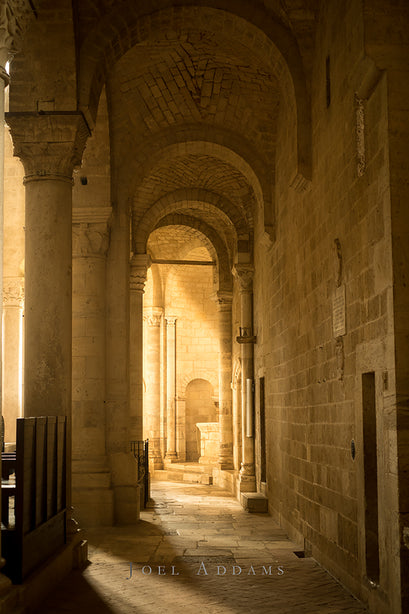Two things get me really excited to teach photography, and they have very little to do with the actual location of the workshop. The first is the level of hunger of the participant. The second is the participant's level of enthusiasm after the pictures have been taken. When photographers want their next great photograph like their next breath, I am highly motivated to make things happen so they can get that. When I hear the cheers of excitement when they see the results, everyone is set on fire. I was guest instructing for Drake Busath's Italy Workshop, "Intimate Tuscany," in May of 2013 and was lucky enough to have a slew of participants who met both criteria. And we had a blast.
Drake had led the group to an age-old abbey in Tuscany one morning, a frequent stop on his tour. We had dutifully piled out hoping to catch a few of the monks roaming about in the morning light of the church. We entered the church just after services, and the group hesitantly started clicking away, unsure if it was truly as acceptable as Drake had mentioned. All the elements were set: early warm morning light, a great backdrop of the church, monks milling about.
I noticed one participant who seemed both excited and frustrated at the same time. "Are you getting what you want?" I asked, a common approach question for me as an instructor. The answer is often, "No," and it allows the photographer to verbalize exactly what he or she is missing. On this instance, she was not getting the monk moving in the scene how she wanted. I recognized what the issue was. Unlike Cartier-Bresson, she was not anticipating the shot. HCB practiced the principle of anticipation over and over, finding a geometry in the cityscape or scene in front of him and then waiting for the right person or bike or bird to come shooting by. Admittedly, it's hard to wait when such a great scene is in front of you!
She and I set up in a place where we could see the scene, meter the scene, and then focus on the area where we would anticipate the monk walking by. That is what we wanted. We could envision him isolated as a subject in the archway of the side corridor, walking, with some handsome warm light all around. We set our cameras at an acceptable exposure, and handheld. I opted for f/2.8 to then have a corresponding shutter speed that would slightly blur the walking monk, 1/30 of a second. I metered the scene again. I focused on the area where he would be walking and locked my setting on my Fujifilm X-Pro 1 and 14 mm lens. We waited.
And then the monk walked by 50 feet behind the anticipation spot. Blast!
We laughed for a minute, as things never quite work out when not on a production set, and went back to work reseting everything. Finally, the monk walked back and forth dutifully as if on cue and we both snapped away, delighted by the results. The lesson was clear to both of us. Anticipation in some circumstances will make a great finished photograph look like the photographer just "happened by" and that everything worked out well. The truth is though, that careful consideration in some situations will make you and me the prepared students of light and circumstance and will allow us to bring home some keepers.
If you’d like to bring some keepers home, check out Drake Busath's Italy Workshops for 2014.
KEEP UP WITH JOEL: Website | Blog | Facebook | Instagram | Twitter
KEEP UP WITH DRAKE BUSATH: Website | Italy Workshops





